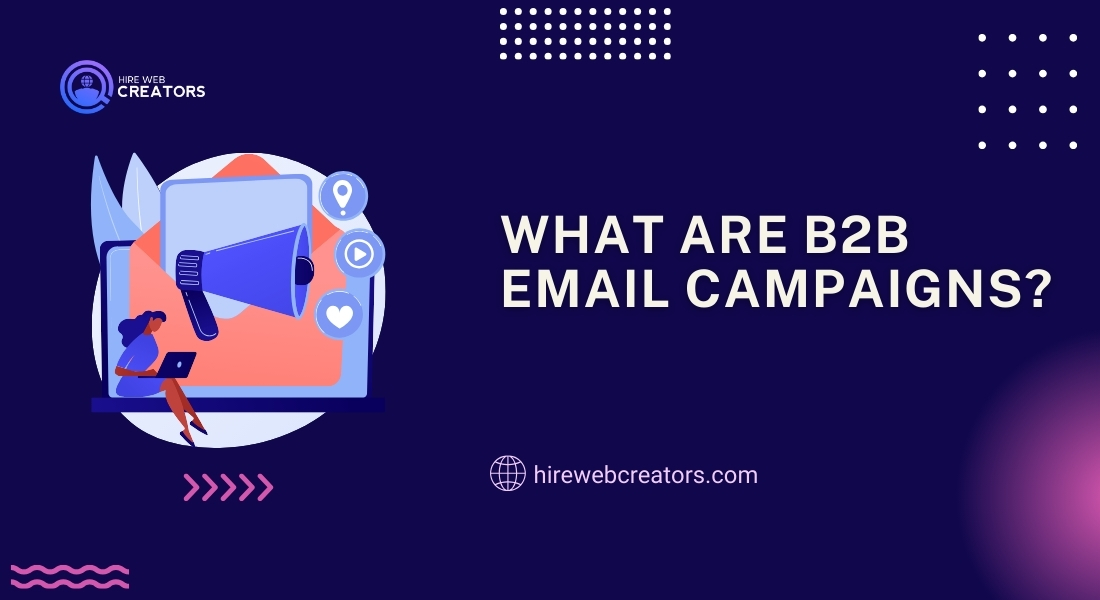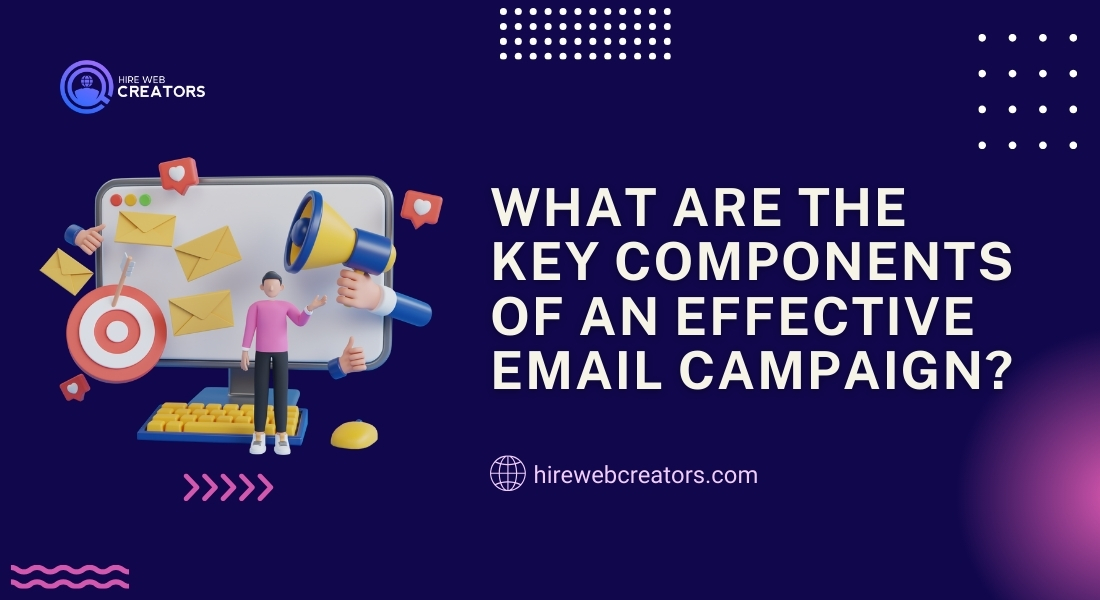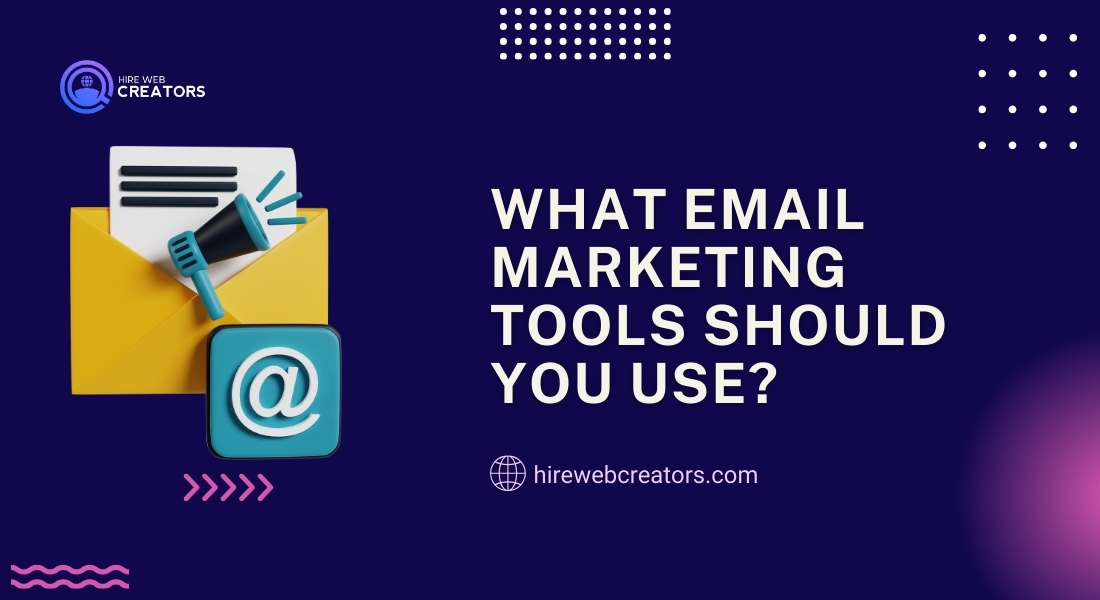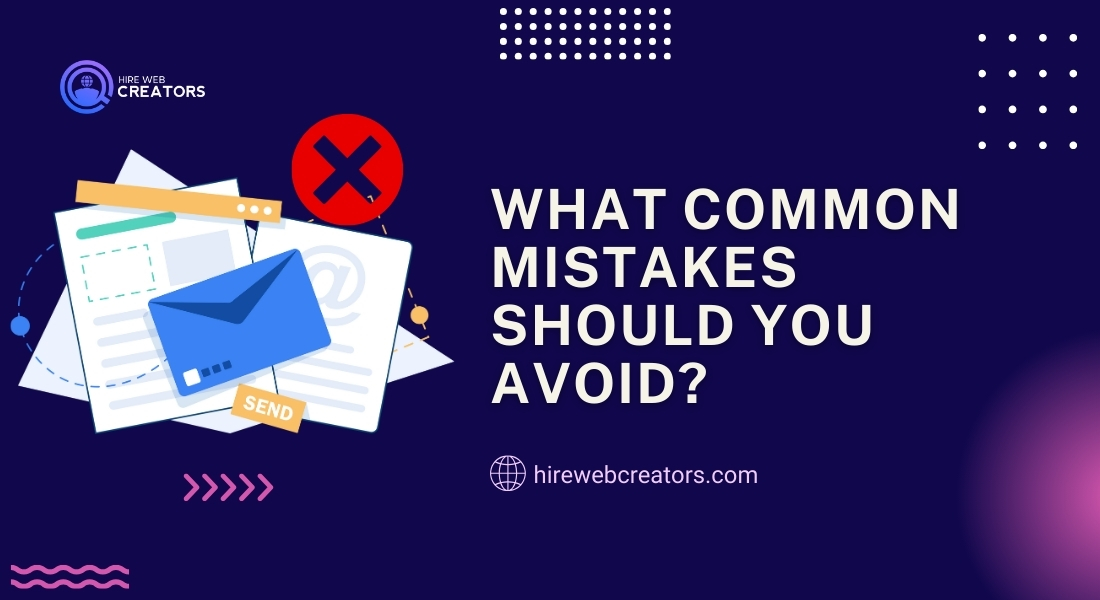

B2B Email Campaigns: 15 Crucial Mistakes to Avoid for Success!
Supercharge your B2B email campaigns! Discover expert strategies to captivate clients and maximize conversions for your web development agency.
Effective B2B email campaigns are necessary for every web development agency, as it is one of the major means to engage clients and drive conversions in the competitive digital landscape of today. Email marketing has retained its position as one of the most influential tools in a marketer’s arsenal since it facilitates a line of communication directly to potential and current clients. With this kind of targeted messaging and using personalized content, agencies can be able to build a relationship and display expertise.
This blog will walk you through all the major components of effective email campaigns for B2B audiences from defining your audience to great subject lines and understanding how successful your campaigns are. We will share the knowledge and strategies you need to make your email marketing campaigns some of the most effective work you do and drive some amazing results for your agency. Get ready to revolutionize your email campaigns and make a real difference in your agency’s impact!
What are B2B Email Campaigns?
B2B email campaigns are strategic marketing efforts designed to promote products or services to other businesses rather than individual consumers. These campaigns leverage email as a direct communication channel to engage potential clients, nurture leads, and foster relationships with existing customers. Unlike B2C email marketing, which often focuses on impulsive purchasing decisions, B2B email campaigns require a more thoughtful approach, as business clients typically seek valuable information, insights, and solutions to specific challenges they face.

At the core of effective B2B email campaigns is a clear understanding of the target audience. Businesses need to define their ideal customer profiles, considering factors such as industry, company size, and pain points. By segmenting their email lists based on these criteria, agencies can tailor their messages to address the unique needs of each group. This level of personalization not only enhances the relevance of the content but also increases engagement rates, making it easier for businesses to establish trust and credibility with their clients.
Furthermore, successful B2B email campaigns rely on delivering valuable content that resonates with the audience. This may include case studies, industry reports, or insights into market trends that position the agency as a thought leader. By consistently providing high-quality content, businesses can nurture leads throughout the buyer’s journey, guiding them from initial awareness to final decision-making. Ultimately, mastering the art of B2B email campaigns enables agencies to build lasting relationships and drive sustainable growth.
Why are Email Campaigns Important for B2B Web Development?
Email campaigns are a cornerstone of effective marketing strategies for B2B web development agencies. They offer a direct and personal way to communicate with potential clients, allowing businesses to deliver tailored messages that address specific needs. This personalized approach not only enhances engagement but also fosters trust between agencies and their clients. In an era where information overload is common, email campaigns cut through the noise, providing valuable insights and solutions that resonate with businesses.
The importance of email campaigns in B2B marketing is underscored by their impressive return on investment (ROI). Studies have shown that email marketing consistently delivers higher ROI compared to other digital marketing channels. This cost-effective method allows agencies to reach a wide audience without incurring exorbitant expenses. By focusing on creating compelling content and targeted messaging, agencies can maximize their marketing budget while still achieving significant results.
B2B email campaigns also play a vital role in nurturing leads and guiding them through the sales funnel. Businesses often take longer to make purchasing decisions, requiring multiple touchpoints before converting. Email campaigns enable agencies to stay top-of-mind with prospects, providing ongoing value through informative content and updates. By establishing a consistent communication flow, agencies can effectively position themselves as trusted partners, ultimately increasing the likelihood of conversion and long-term client relationships.
What Are the Key Components of an Effective Email Campaign?
An effective email campaign is built on several key components that ensure its success. The first essential element is a well-defined objective. Whether the goal is to generate leads, promote a new service, or re-engage previous clients, clarity in objectives helps shape the campaign’s messaging and strategy. Establishing clear goals allows agencies to measure their performance effectively and make necessary adjustments to optimize results. By aligning the campaign’s purpose with the needs of the target audience, businesses can craft emails that resonate and drive action.

Another crucial component of successful B2B email campaigns is engaging subject lines. The subject line is often the first impression a recipient has of an email, making it a vital factor in determining open rates. A compelling subject line should be concise, relevant, and intriguing enough to prompt the recipient to click. Including personalization elements, such as the recipient’s name or company, can further increase engagement. By investing time in crafting effective subject lines, agencies can significantly enhance the impact of their email campaigns.
Content quality is equally important in B2B email campaigns. Emails should provide valuable insights, industry trends, or solutions that address the recipients’ challenges. Agencies should focus on delivering relevant and informative content that positions them as experts in their field. A strong call to action (CTA) is also essential, guiding recipients toward the desired action, whether it’s visiting a website, signing up for a webinar, or downloading a resource. By integrating these components, businesses can create impactful email campaigns that not only capture attention but also drive meaningful engagement.
How to Define Your Target Audience for B2B Email Campaigns?
Defining the target audience is a critical step in creating successful B2B email campaigns. Understanding who the ideal clients are allows agencies to tailor their messaging and content to meet the specific needs of different segments. This involves creating detailed buyer personas based on demographics, industry, company size, and pain points. By researching the target audience, agencies can gain insights into their preferences and challenges, enabling them to craft messages that resonate effectively.
Segmenting the audience further enhances the effectiveness of email campaigns. By categorizing recipients based on shared characteristics or behaviors, agencies can send more personalized and relevant content. For instance, a web development agency may segment its audience into categories such as startups, established businesses, and nonprofits, each requiring different approaches. This targeted segmentation not only increases engagement rates but also fosters stronger relationships with clients, as they feel that the agency understands their unique challenges.
Monitoring engagement metrics is essential for refining the target audience. Analyzing open rates, click-through rates, and conversion rates can provide valuable feedback on how well the email content resonates with recipients. Agencies should continuously evaluate their audience segmentation and make adjustments based on performance data. By staying responsive to the needs and behaviors of their audience, businesses can enhance the effectiveness of their B2B email campaigns and ultimately achieve better results.
What Email Marketing Tools Should You Use?
Selecting the right email marketing tools is crucial for executing successful B2B email campaigns. Various platforms offer features designed to streamline the email marketing process, making it easier for agencies to create, send, and analyze their campaigns. Key features to look for include automation capabilities, list segmentation, and analytics tracking. These functionalities allow agencies to tailor their campaigns and measure their effectiveness efficiently.

Popular email marketing tools like Mailchimp, HubSpot, and Constant Contact provide user-friendly interfaces and robust features. These platforms allow agencies to design visually appealing emails, segment their audience for targeted messaging, and automate follow-up sequences based on recipient behavior. The ability to schedule campaigns in advance also ensures timely delivery, crucial for maximizing engagement. By leveraging these tools, agencies can focus on creating high-quality content while the software manages the logistics of email distribution.
Analytics is another essential component of effective email marketing tools. Agencies should prioritize platforms that offer in-depth reporting on key metrics such as open rates, click-through rates, and conversion rates. This data provides insights into the performance of email campaigns, enabling businesses to refine their strategies over time. By continually monitoring and analyzing campaign results, agencies can make data-driven decisions that enhance the impact of their B2B email campaigns.
How to Craft Compelling Subject Lines?
Crafting compelling subject lines is a vital skill for B2B email campaigns, as they significantly influence open rates and overall engagement. The subject line serves as a preview of the email’s content, making it essential to create a sense of curiosity or urgency that encourages recipients to click. Effective subject lines should be concise, typically between 6 to 10 words, while conveying the email’s value. Avoiding jargon and overly complex language can help ensure clarity and improve comprehension.
Incorporating personalization into subject lines can greatly enhance their effectiveness. Including the recipient’s name, company, or specific pain points can create a more engaging experience. For example, a subject line like “John, Improve Your Website’s Performance Today!” directly addresses the recipient and highlights a relevant benefit. This personalized approach not only captures attention but also makes the recipient feel valued, increasing the likelihood of engagement.
Testing different subject lines is essential for optimizing performance. A/B testing allows agencies to compare the effectiveness of various subject lines and determine which resonates best with their audience. By analyzing open rates and engagement metrics, businesses can refine their subject line strategies over time. Ultimately, mastering the art of crafting compelling subject lines is a crucial aspect of creating successful B2B email campaigns that drive meaningful interactions.
What Content Should Be Included in Your Emails?
The content included in B2B email campaigns plays a pivotal role in engaging recipients and driving conversions. Agencies should focus on delivering valuable, relevant information that addresses the specific needs and interests of their audience. This can include industry insights, how-to guides, case studies, and updates about the agency’s services. By providing content that solves problems or offers solutions, businesses can position themselves as trusted authorities in their field.
Visual elements are also important in enhancing the effectiveness of email content. Including images, infographics, or videos can make emails more engaging and help convey complex information more clearly. However, it is essential to strike a balance between visuals and text, ensuring that the content remains informative and easy to digest. A well-structured layout with clear headings and bullet points can improve readability, making it easier for recipients to absorb the key messages.
A strong call to action (CTA) is crucial for guiding recipients toward the desired outcome. Every email should have a clear and compelling CTA that encourages readers to take the next step, whether it’s visiting the website, signing up for a webinar, or requesting a consultation. By integrating valuable content with persuasive CTAs, agencies can effectively drive engagement and conversions through their B2B email campaigns.
How to Personalize Your Email Campaigns?
Personalization is a powerful strategy in B2B email campaigns that can significantly enhance engagement and effectiveness. It involves tailoring emails to meet the specific preferences and needs of individual recipients, creating a more relevant and meaningful experience.

Basic personalization can include addressing recipients by their names, while more advanced techniques involve segmenting the audience based on behavior, interests, and past interactions. This level of customization allows agencies to deliver content that resonates with each recipient, increasing the likelihood of engagement.
Utilizing data-driven insights is essential for effective personalization. By analyzing recipient behavior, such as past purchases or website interactions, agencies can gain valuable insights into what content is most relevant. For example, if a recipient previously downloaded a guide on web development, sending them a follow-up email with related resources or services can enhance their experience. By leveraging this data, agencies can create targeted campaigns that address specific pain points and interests, ultimately leading to higher conversion rates.
A/B testing can further optimize personalized email campaigns. Agencies should experiment with different personalization techniques to see what resonates best with their audience. This might include varying the level of personalization, testing different messaging approaches, or trying out different content formats. By continuously refining their strategies based on performance metrics, businesses can ensure that their B2B email campaigns remain relevant and effective in engaging clients.
What is the Optimal Frequency for Sending Emails?
Determining the optimal frequency for sending emails is a crucial aspect of successful B2B email campaigns. Striking the right balance is essential to avoid overwhelming recipients while maintaining consistent engagement. Research indicates that sending one to four emails per month is generally effective for B2B audiences, but the ideal frequency can vary depending on the target audience and the nature of the content. Agencies should consider their audience’s preferences and industry standards when establishing their email schedule.
Monitoring engagement metrics can help businesses fine-tune their email frequency. Analyzing open rates, click-through rates, and unsubscribe rates provides insights into how recipients are responding to the current schedule. If engagement drops or unsubscribe rates increase, it may indicate that emails are being sent too frequently. Conversely, low engagement may suggest that recipients are not receiving enough communication. By adjusting the frequency based on these metrics, agencies can optimize their email campaigns for better results.
A/B testing can also play a significant role in determining optimal email frequency. By experimenting with different sending schedules and analyzing the impact on engagement, agencies can identify the frequency that resonates best with their audience. Regularly reassessing email frequency ensures that campaigns remain effective and aligned with the preferences of recipients, ultimately enhancing the success of B2B email campaigns.
How to Analyze the Success of Your Email Campaigns?
Analyzing the success of B2B email campaigns is essential for understanding their effectiveness and making informed decisions for future strategies. Key performance indicators (KPIs) such as open rates, click-through rates, conversion rates, and unsubscribe rates provide valuable insights into how well the campaigns are resonating with the target audience. Tracking these metrics allows agencies to assess which elements of the campaigns are working and which need improvement.
Utilizing analytics tools can enhance the analysis process. Many email marketing platforms offer built-in reporting features that allow agencies to track performance in real-time. These tools provide detailed insights into recipient behavior, such as how long they spend reading emails and which links they click. By leveraging this data, agencies can identify trends and patterns that inform their email marketing strategies, enabling them to make data-driven decisions that improve future campaigns.
Feedback from recipients can also be a valuable resource for analyzing campaign success. Conducting surveys or soliciting direct feedback can provide insights into how recipients perceive the content and frequency of emails. Understanding their preferences and challenges allows agencies to tailor future campaigns more effectively. By combining quantitative metrics with qualitative feedback, businesses can develop a comprehensive understanding of the success of their B2B email campaigns and make informed adjustments to enhance their overall effectiveness.
What Common Mistakes Should You Avoid?
Avoiding common mistakes is crucial for the success of B2B email campaigns. One of the most significant pitfalls is neglecting to segment the audience properly. Sending generic emails to a broad audience can lead to low engagement rates, as recipients may not find the content relevant to their needs. By failing to tailor messages to specific segments, agencies miss the opportunity to connect meaningfully with their audience. Effective segmentation allows for more targeted communication, ultimately leading to higher engagement and conversion rates.

Another common mistake is not optimizing emails for mobile devices. With a growing number of users accessing emails on smartphones and tablets, failing to ensure that emails are mobile-friendly can result in poor user experiences. Emails should be designed with responsive layouts that adapt to various screen sizes, making it easy for recipients to read and interact with the content. A mobile-optimized email enhances accessibility and increases the likelihood of engagement, making it an essential consideration for B2B email campaigns.
Ignoring analytics and performance metrics is another mistake that can hinder campaign effectiveness. Agencies should actively monitor key performance indicators to understand how their emails are performing. By neglecting to analyze open rates, click-through rates, and conversion rates, businesses risk missing valuable insights that could inform future strategies. Regularly reviewing performance data allows agencies to identify areas for improvement and adjust their approaches accordingly, ensuring that their B2B email campaigns continually evolve and succeed.
How to Integrate Your Email Campaigns with Other Marketing Efforts?
Integrating B2B email campaigns with other marketing efforts can enhance their overall effectiveness and reach. A cohesive marketing strategy ensures that messaging is consistent across all channels, reinforcing brand identity and increasing recognition. To achieve this, agencies should align their email content with ongoing marketing initiatives, such as social media campaigns, blog posts, and webinars. This integrated approach allows for cross-promotion and encourages recipients to engage with the brand through multiple touchpoints.
Leveraging customer relationship management (CRM) systems can facilitate the integration of email campaigns with other marketing efforts. By syncing email marketing platforms with CRM systems, agencies can gain valuable insights into customer interactions and preferences. This data allows businesses to tailor their email campaigns based on previous engagements, ensuring that the content remains relevant and personalized. Furthermore, tracking customer interactions across various channels enables agencies to create more targeted and effective email campaigns that resonate with their audience.
Measuring the impact of integrated marketing efforts is essential for assessing their success. Agencies should track how email campaigns contribute to overall marketing goals, such as lead generation and brand awareness. Analyzing performance metrics can help businesses identify which channels work best in conjunction with email marketing, allowing them to refine their strategies. By fostering a collaborative marketing approach, agencies can maximize the effectiveness of their B2B email campaigns and drive better results.
In conclusion, crafting effective email campaigns for B2B web development agencies is essential for fostering meaningful connections with potential clients and driving conversions. By understanding the importance of personalized messaging, identifying the target audience, and leveraging the right tools, agencies can create campaigns that resonate with recipients. The integration of compelling subject lines, valuable content, and strong calls to action further enhances the overall impact of these campaigns. As email marketing continues to evolve, staying informed about best practices will empower agencies to remain competitive and effectively engage their audience.
Ultimately, the success of B2B email campaigns lies in continuous analysis and improvement. By monitoring key performance indicators and incorporating feedback from recipients, agencies can refine their strategies and optimize their outreach efforts. This commitment to excellence will not only elevate the effectiveness of email marketing but also strengthen the agency’s reputation as a trusted partner in the web development industry. By prioritizing thoughtful execution and ongoing optimization, agencies can ensure their email campaigns deliver substantial value and drive lasting results.
